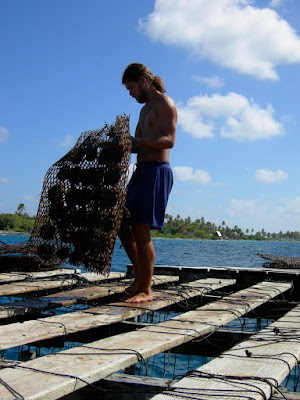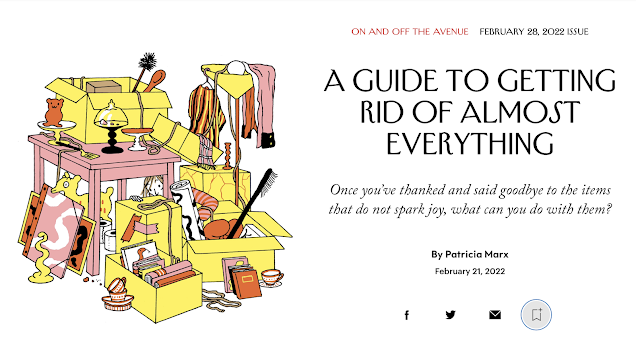Pearls: Sustainability and the seas
Happy Pearl Month! We'll see a few more pearls in the Passage's windows in June.
The issue of sustainability is ever more important when buying gems and precious metals.
I asked Sarah Canizzaro, owner of Kojima Company, whether pearls from some locations are more sustainably raised than from others. That petite bundle of pearl passion sent a detailed reply, which I'll abridge here.
She said "Yes!", and named three locations as especially responsible producers:
 1. Tahiti (French Polynesia and other small atolls): "There are farms who see the larger picture and are actively working with the entire food chain of their particular environment and not solely for the benefit of their aquaculture profits...
1. Tahiti (French Polynesia and other small atolls): "There are farms who see the larger picture and are actively working with the entire food chain of their particular environment and not solely for the benefit of their aquaculture profits...
I believe that the farms of Polynesia are some of the most sustainable in the world, especially those who do not engage in cleaning their oysters with pressure washers. They have no other choice but to work with nature out there."
At left, strictly for educational purposes, a Tahitian farmer at work.
2. Japan's Lake Kasumi-mi-gaura: "Japanese Kasumi pearls come from very, very small boutique farms. The quantity harvested from each farm in a year is so small that when looking at the pearl market as a whole it is almost not worth mentioning, except their environmental commitments have not only provided them with decades of beautiful pearls, they have also been great leaders in their communities. They have been personally responsible for cleaning up the water there."
3. Mexico's Sea of Cortez: These pearls are farmed by three marine biologists and their staff at North America's only saltwater pearl farm. Sarah says, "There are absolutely no dyes or treatments used on Sea of Cortez pearls.
Not only have these three farmers banned fishing in Bacochibampo Bay, the indigenous staff sing softly in the breeze when the pearls are harvested (really they do, it's magical). Also all by-products are sold or used."
Above: Harvesting the rainbow-lipped oysters in the Sea of Cortez, and Sarah at the Guaymas, Mexico farm.
For more detail, read Perlas del Mar de Cortez' owner, Douglas McLaurin's article, "5 Reasons Why a Sustainable Pearl Farm is Positive for the Environment".
Regarding Chinese pearls, Sarah notes, "Ninety-nine percent of the world's pearls are grown in China, in small lakes both natural and man-made. It is for the most part a clean process; however, I suspect that the feeding of the mollusks in recent years may be short-sighted and full of an abundance of steroids to increase nacre production.' She also mentioned treatments commonly used on CFWs (dyeing, bleaching and lustre-enhancement), which have environmental consequences.
Sarah ended with a heartfelt comment: "No one dies for pearls. There is no such thing as "blood pearls"; wars are not fought for them. They are generally raised by small family farms who employ local people. Growing pearls is hard work, and farmers are constantly at the mercy of nature. I believe there is no more ethical gem that one can wear and enjoy."
Some pearl candy! Earrings made with each pearl variety mentioned:
1. Left, detail: baroque Tahitian, white CFW and orange sapphire briolette dangle earrings; Judi McCormick Jewelry. Price, $US 325.
2. Top right, Japan Kasumi and pink tourmaline dangle earrings; Kojima Company. Price, $US 1, 107.
3. Bottom right: Hummingbird silver earrings with Sea of Cortez mabé pearls, by Priscilia Canales, sold by Perlas del Mar del Cortez online store. Price, $US 400.
The issue of sustainability is ever more important when buying gems and precious metals.
I asked Sarah Canizzaro, owner of Kojima Company, whether pearls from some locations are more sustainably raised than from others. That petite bundle of pearl passion sent a detailed reply, which I'll abridge here.
She said "Yes!", and named three locations as especially responsible producers:
 1. Tahiti (French Polynesia and other small atolls): "There are farms who see the larger picture and are actively working with the entire food chain of their particular environment and not solely for the benefit of their aquaculture profits...
1. Tahiti (French Polynesia and other small atolls): "There are farms who see the larger picture and are actively working with the entire food chain of their particular environment and not solely for the benefit of their aquaculture profits... I believe that the farms of Polynesia are some of the most sustainable in the world, especially those who do not engage in cleaning their oysters with pressure washers. They have no other choice but to work with nature out there."
At left, strictly for educational purposes, a Tahitian farmer at work.
2. Japan's Lake Kasumi-mi-gaura: "Japanese Kasumi pearls come from very, very small boutique farms. The quantity harvested from each farm in a year is so small that when looking at the pearl market as a whole it is almost not worth mentioning, except their environmental commitments have not only provided them with decades of beautiful pearls, they have also been great leaders in their communities. They have been personally responsible for cleaning up the water there."
3. Mexico's Sea of Cortez: These pearls are farmed by three marine biologists and their staff at North America's only saltwater pearl farm. Sarah says, "There are absolutely no dyes or treatments used on Sea of Cortez pearls.
Not only have these three farmers banned fishing in Bacochibampo Bay, the indigenous staff sing softly in the breeze when the pearls are harvested (really they do, it's magical). Also all by-products are sold or used."
Above: Harvesting the rainbow-lipped oysters in the Sea of Cortez, and Sarah at the Guaymas, Mexico farm.
For more detail, read Perlas del Mar de Cortez' owner, Douglas McLaurin's article, "5 Reasons Why a Sustainable Pearl Farm is Positive for the Environment".
Regarding Chinese pearls, Sarah notes, "Ninety-nine percent of the world's pearls are grown in China, in small lakes both natural and man-made. It is for the most part a clean process; however, I suspect that the feeding of the mollusks in recent years may be short-sighted and full of an abundance of steroids to increase nacre production.' She also mentioned treatments commonly used on CFWs (dyeing, bleaching and lustre-enhancement), which have environmental consequences.
Sarah ended with a heartfelt comment: "No one dies for pearls. There is no such thing as "blood pearls"; wars are not fought for them. They are generally raised by small family farms who employ local people. Growing pearls is hard work, and farmers are constantly at the mercy of nature. I believe there is no more ethical gem that one can wear and enjoy."
If you are interested in pearls from environmentally-conscious producers, contact Sarah or her assistant at Kojima Company; they know their suppliers personally. (Note: No affiliation here, just love.) Many of their pearls are not on the site.
You could ask for such pearls from your local jeweller or a jewellery store; in my experience, few know more than the country of origin.
You could ask for such pearls from your local jeweller or a jewellery store; in my experience, few know more than the country of origin.
Some pearl candy! Earrings made with each pearl variety mentioned:
1. Left, detail: baroque Tahitian, white CFW and orange sapphire briolette dangle earrings; Judi McCormick Jewelry. Price, $US 325.
2. Top right, Japan Kasumi and pink tourmaline dangle earrings; Kojima Company. Price, $US 1, 107.
3. Bottom right: Hummingbird silver earrings with Sea of Cortez mabé pearls, by Priscilia Canales, sold by Perlas del Mar del Cortez online store. Price, $US 400.





Comments
Always feel right in pearls!